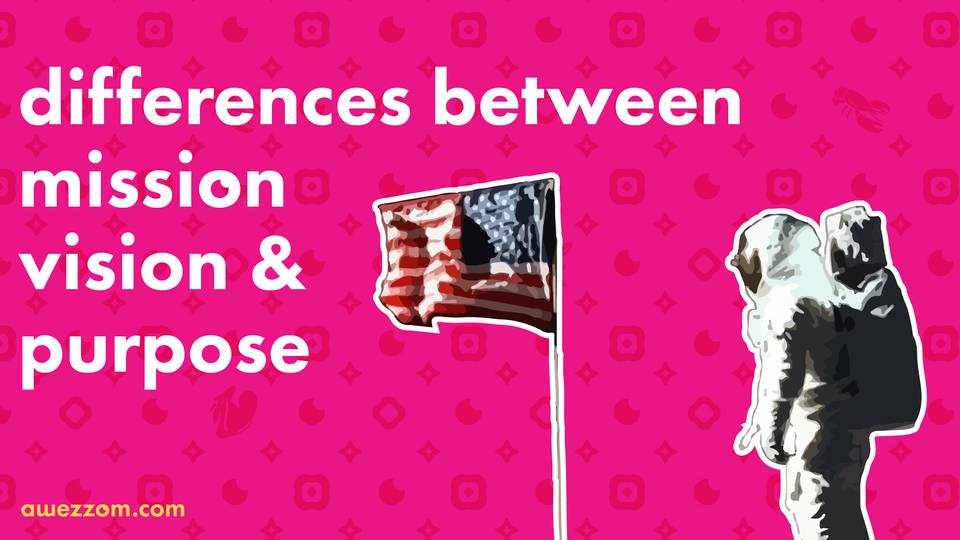I challenge you to find ten mission statements of random firms from your industry and evaluate them. First, there aren’t that many. Second, those you will be able to find will look the same. It is an unfortunate state of affairs — companies just copy mission and vision statements from one another. Not that the original source had a single statement worth copying.
But that’s exactly your opportunity to shine. Since most of your competitors have meaningless slogans, you can really stand out and communicate clearly why you are in business.
The more competitive the marketplace the more choices clients have. It is becoming extremely challenging for buyers to figure out which offer is a better fit for them. In the sea of dull sameness you could make your company more appealing. Your mission and vision could help your clients differentiate your business from everyone else.
What is a Vision statement?
A company’s vision statement is best described with an image. Imagine all of your field missions were successful. Where would all of your successes get your company to? That’s your vision.
Think about where you want your business to be in 5 to 20 years. Paint a vivid picture of your success — that is your vision. A vision statement is merely a verbal representation of that image.
It can be rather daunting to be able to put your company’s image into clear, concise and compelling sentences. If you rather feel like having an expert create a vision statement for your firm, contact me to make this happen.
Bad vision statement examples
This is an example of a terrible vision statement: “Our Vision is to provide many opportunities so that lives of many can benefit from the new possibilities available to them.” What are you talking about?
Here’s another one: “To create a different kind of law firm, putting culture first, with great people doing the best legal work for our clients.” At least some specificity in this one but too generic regardless.
And the third one — “Excellence and leadership...improving the health of our community.”
These are so bad that it breaks my heart just by having to look at them. I am sure these companies have great people working there but they could surely use some assistance with formulating their vision statements.
Examples of powerful vision statements
My favourite vision statement is from J.F.Kennedy’s address at Rice University on the Nation's Space Effort, on September 12, 1962. He did not say it using the exact words but, based on his speech, the implied vision basically was: “A man on the Moon by the end of 1960s.” Now that is a powerful vision. You can actually create a mental image of a person on the surface of the moon holding a U.S. flag.
Here is a list of great vision statements from well-known companies:
- Amazon — earth’s most customer-centric company.
- Google — to provide access to the world's information in one click.
- Southwest Airlines — to become the world’s most loved, most flown, and most profitable airline.
- Microsoft — a computer on every desk and in every home.
- Disney — the world’s premier entertainment company.
- McDonald’s — the world’s best quick service restaurant experience.
- PayPal — affordable and convenient financial services as a right for all rather than a privilege for the few.
- Tesla — create an entire sustainable energy ecosystem.
I find Microsoft’s vision to be very compelling as well. For the same reason — you can create a mental image of computers on every desk and in every home.
What is a Mission statement?
Think of your company’s mission in terms of actions that are supposed to generate value. The value isn’t just money. It isn’t just the value you can derive from your efforts but it is the kind of value that you will bring to the table in each business transaction.
Your mission statement has to reflect the kind of company’s services that either implicitly or explicitly state the benefits your clients should expect to receive.
Bad mission statement examples
This one is a terrible mission statement. I am leaving the company name out for obvious reasons.
“(COMPANY NAME) is committed to creating and sustaining an environment of positive energy where people embrace hard work, pursue excellence, keep their promises, commit to courage, have fun, and develop meaningful relationships.”
Why is this a bad mission statement? Because anyone can say exactly the same things about their company. There are no specifics here — it’s all vague. At best, this is an exempt from a company credo. Or this looks like a list of core values.
Here is another example: “To be a dynamic, client-focused organization oriented toward growth and recognized for excellence in the (_blank_) services field by creating measurable value for our clients in the accomplishment of their (_blank_) service needs through the unique application of innovative, consistent and dependable services.”
And this one belongs to a multi-billion dollar corporation: “For more than 160 years, the role (COMPANY NAME) plays has always been underpinned by the need for trust and our ability to deliver solutions. Our purpose brings meaning to our daily work, guides our decision-making and inspires action in a dynamic environment. It demonstrates our ongoing, clear commitment to working collaboratively and innovatively to deliver the highest quality outcomes for our people, clients and society.”
Bad, bad mission statements. Too long. Too cumbersome. Too vague. Too pompous.
Examples of powerful mission statements
Here are a number of awesome vision statements from well-known companies:
- Google — deliver the most relevant and reliable information available; maximize access to information.
- Virgin Group — provide incredible experiences, challenge the status quo, while championing people and the planet.
- LinkedIn — create economic opportunity for every member of the global workforce.
- Facebook — give people the power to build community.
- Disney — entertain, inform and inspire people around the globe.
- Netflix — give access to best-in-class TV shows, movies and documentaries; everywhere, whatever your taste.
- Tesla — enable homeowners, businesses, and utilities to manage renewable energy generation, storage, and consumption.
- Amazon — build a place where people can come to find and discover anything they might want to buy online.
- PayPal — make the movement and management of money as simple, secure and affordable as possible.
My favourite mission statements are from Tesla, PayPal, Linkedin and Google. They are so concise, clear and to the point that it makes me want to cry (with benevolent envy and pride).
Take Google’s mission statement for example. They state it clearly that they are in the business of “delivering information”. The benefits for their “customers” are that this information is “relevant and reliable”. One short sentence says it all.
What is a Purpose statement?
To put it as simply as possible — the purpose statement of the company must provide an answer to a very specific question — why is your company in this business beyond making money. The purpose lies in the “Why” question.
Why do you get up so early every single morning to slave away at your work? You could be doing something else but you’re not. If you can provide an answer to these questions on a personal level you are half way there to find a purpose for the whole company.
Remember, the purpose of your business doesn’t have to be on display. It’s good if you can communicate it. But it’s not a must. So if you have nailed your vision and mission statements you can easily keep your purpose private. But every single employee has to know your company has a purpose. Preferably by heart.
Bad purpose statement examples
The same multi-billion dollar company mentioned in the bad mission statements’ examples has this purpose statement: “(COMPANY NAME) strives to build trust in society and solve important problems. It defines the difference we seek to make in the world — it's why we do what we do.”
Can you name this company by reading this purpose statement? Which company can’t say that they themselves “solve important problems”? How more vague can this be? “Why we do what we do,” — just tell me what you do already!
The following example isn’t precisely bad, but it isn’t powerful either: “To help create positive, enduring change in the world.” Again — way too many companies actually create “positive, enduring change”.
This is yet another example of a poorly stated purpose of the company: “Through collaboration, expertise and innovation, we promote progress and inspire our clients, employees, investors and communities to achieve their greatest potential.”
Two or more companies can have similar purposes. It is essential however that a purpose statement makes sense for the industry the company is in. So even though you could just copy a purpose statement from another company (and I never said that you should) you’d still have to make sure it applies to your business.
Examples of powerful purpose statements
There aren’t many good purpose statements out there. One reason is that companies don’t have to publicise their purpose. Here is a list of great purpose statements from well-known businesses:
- Tesla — accelerate the world’s transition to sustainable energy.
- Starbucks — inspire and nurture the human spirit – one person, one cup and one neighborhood at a time.
- Nike — bring inspiration and innovation to every athlete in the world. If you have a body, you are an athlete.
- Google — organize the world's information and make it universally accessible and useful.
- Virgin Group — to change business for good.
- PayPal — democratize financial services.
- Disney — create happiness for others; make people happy.
- Facebook — bring the world closer together.
- Southwest Airlines — connect people to what’s important in their lives through friendly, reliable, and low-cost air travel.
My favourite purpose statements are: Tesla’s, PayPal’s and Google’s.
The key differences between company’s mission, vision and purpose
The purpose of the business lies beyond making money. The purpose statement can be internal. What makes it different from both mission and vision is that your company’s purpose MUST remain the same. The mission and vision can change in time — not your purpose. If you ever find yourself in a situation where the purpose of the company had changed — it becomes a different company.
The mission of the company is what gets your business to its vision in 5, 10 or 20 years. Your mission is a strategic plan of generating value for your company and your clients. Business mission supports your company’s vision.
Company’s vision is different from its mission in the same ways that a destination is different from the trip itself. Think of your company’s vision as of your mission’s success. You set out to get somewhere and then you finally did. Imagine that place and then work your way backwards figuring out the business objectives to attain and tools to invest in to help you arrive at your destination.
Your company’s vision can change. Once you get to where you want to be or if you consider that it would be prudent to select a new destination — you can change your vision.
Read the following article on how to develop powerful mission and vision statements for your firm.
Watch this video to learn more about company mission, vision and purpose
The awezzom question of the day:
What business is our company in?

